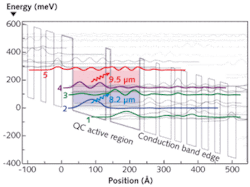A team of researchers has developed a mid-IR quantum-cascade (QC) laser that exhibits dual-wavelength emission. One of the wavelengths arises from a novel mechanism for QC laser emission and is emitted at a temperature quite atypical for QC lasers, opening up new possibilities for laser applications in medical diagnostics and environmental sensing.
The team, including researchers from Princeton University (Princeton, NJ) and the University of Sheffield (Sheffield, England), is led by Claire Gmachl, professor of electrical engineering at Princeton University and director of the Mid-Infrared Technologies for Health and the Environment (MIRTHE) center.1
“This laser teaches us that we need to reexamine our understanding of QC lasers and look more broadly into the carrier dynamics in the lasers; doing so can potentially provide us with improved laser performance in the future,” says Kale Franz, graduate student at the Department of Electrical Engineering, Princeton University. “And improved laser performance directly translates into improved spectroscopic laser systems and more versatile and lower-cost systems for applications,” adds Gmachl.
The high k-space (k is a wave number that represents the momentum state of an electron) laser discovery was made when Kale Franz and his colleague Stefan Menzel followed up carefully with some initially puzzling data on the temperature-related performance of an unexpected second laser wavelength.
Lasers function by the mechanism of population inversion, in which electrons are elevated to higher energy states so that they can create photons as they drop down. Within individual energy bands, electrons usually “pool” at the lowest k-space values at and around zero. Optical transitions and lasing occur from these low-k-value electron pools. In QC lasers, population inversion is maximized by using spatially delocalized energy states populated with quasi-equilibrium electrons at approximately zero k values.
The research team began its work with a unique QC laser structure designed to lase using the 5-to-4 optical transition on its conduction-band energy diagram (see figure). Conventional QC lasers are typically designed to lase between states 3 and 2. However, because the team chose to design for laser action between states 5 and 4, lower-energy-level transitions were also present, such as between states 4 and 2. The researchers discovered that these lower-energy transitions are also able to lase. The result was a “dual-wavelength” QC laser that lased simultaneously at 9.5 µm (5-to-4 transition) and 8.2 µm (4-to-2 transition).
The researchers also discovered that the unexpected 4-to-2 transition had the unique property of lasing high in k-space. One loss mechanism of QC lasers happens when electrons in the upper laser state give off phonons rather than photons. In the researchers’ specific laser design, “phonon leakage” out of state 5 has the effect of populating state 4 at high k-space. Typically in QC lasers, the process of resonant tunneling populates an upper laser state at k of approximately zero. The 4-to-2 lasing transition happens at high k-space because of the electron dynamics of their specific design.
Interesting properties for the second wavelength
Besides the presence of dual-wavelength emission, the most exciting part of the discovery is the fact that the high k-space 8.2 µm transition has some very interesting features related to temperature and threshold current. At operating temperatures around 80 K, these two wavelengths lase simultaneously. The 5-to-4 transition wavelength behaves like a typical QC laser intersubband optical transition; that is, its highest output power and lowest threshold current are achieved at low temperatures, up to about 125 K for the 9.5 µm wavelength. However, the 4-to-2 transition wavelength of 8.2 µm behaves differently: lasing is most efficient at a higher temperature near 100 K, whereas performance is significantly decreased at lower temperatures. For the 1.48 mm wide × 12.1 µm long device, the 4-to-2 transition has a lower current threshold than the 5-to-4 transition at values of 85 K and above.
Laser-rate equations used to model the stimulated emission indicated that at elevated temperatures, electrons move out of the 5 energy level and populate the 4 level, then favor the 4-to-2 transition. In addition, the optical absorption loss for the 4-to-2 transition wavelength is approximately 10 times less than for typical QC lasing transitions; in effect, this 8.2 µm wavelength represents far more efficient lasing than that obtained for typical QC structures. Such a discovery opens the door to laser designs that make more cognizant use of k-space distributions, with the potential for more energy-efficient devices that can operate at higher temperatures.
While the researchers were able to discover high k-space lasing through their investigation of a new QC laser design strategy, “We got lucky,” said Franz. “This QC design wasn’t intended for high k-space lasing.” Future research will look at optimizing the k-space lasing process.
REFERENCE
- K.J. Franz et al., Nature Photonics 3(1) p. 50 (January 2009).

